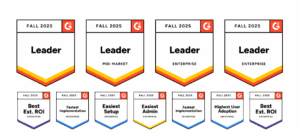Since enlisting the help of Trintech in 2011, HP has experienced a massive overhaul of manual processes for a streamlined, automated approach to the financial close.
Studying HP’s financial journey will give you insight into how to best execute a financial transformation within your organization. As Jackie Peters, the General Accounting Design, Process & Systems Senior Manager of HP, says, “it’s not a project, but a journey of continual improvement.”
Key Takeaways from HP’s Financial Transformation Journey
Clarity is Crucial
Clarity of how technology benefits your organization is essential. If you cannot understand how technology will work for you, you cannot adequately explain it to the members of your team who will be using it daily. Trintech and HP worked together to develop a roadmap for HP’s financial transformation journey that benefits every member of their organization.
“When we were doing reconciliations by Excel spreadsheets, we were looking for a tool because we knew we were doing more work than we needed to do. Plus, we knew we needed more visibility into what was going on in our balance sheet.” – Jackie Peters
According to Jackie Peters, HP won Best in Class because Trintech helped improve daily cash flow visibility. HP also improved the methodology for their financial close, going from an unmanageable, manual quarterly close to a real-time, automated monthly close with increased visibility. By moving to a risk-based approach, HP reduced risk while improving overall productivity.
Technology is Only the First Step
Using the right technology is a good first step, but it cannot be the only step, stresses Peters. HP leverages technology to provide insights to their teams around bottleneck areas, who use those insights to streamline their processes and focus on a higher-level financial transformation. Their teams remove non-value-adding tasks and innovate in ways they previously didn’t have the bandwidth to tackle.
Peters calls this their “continuous improvement” strategy. Constantly asking “why” and “how” about ongoing data patterns and executing a thorough change management plan is part of this strategy. This strategy allows HP to keep track of everything and implement a risk-based approach to be aware of any possible problem areas.

Always Keep the Future in Mind
Support and engagement on every level of the organization are imperative to successfully implementing using any tool, according to Peters. Every team member should be able to express their comments, concerns, and ideas freely. Moving forward is a group effort, and everyone is important to the organization’s bigger picture.
“Standardizing financial processes and accounting procedures is really about a journey; looking at people, processes, and technology and understanding how those all fit, and understanding that it’s a journey, it’s not simply buying a tool or software.” – Jackie Peters
Keeping up with competitors and analyzing their strategies is also incredibly important. “Keep current, and be vocal,” Peters says. Ongoing and robust research into what’s happening in your industry is imperative to staying ahead.
Most importantly, remember that change is an ongoing journey and will never truly end. By the time you’ve reached the initial goals, technology has probably advanced from your start point, and “Best in Class” has evolved. Having a mindset of continuous change is essential to remain competitive.
HP understands that leveraging automation is important to continuous improvement, as it gives the organization ways to streamline processes, improve employee engagement, and increase visibility across the board.
Written By: Breck Sunlin


